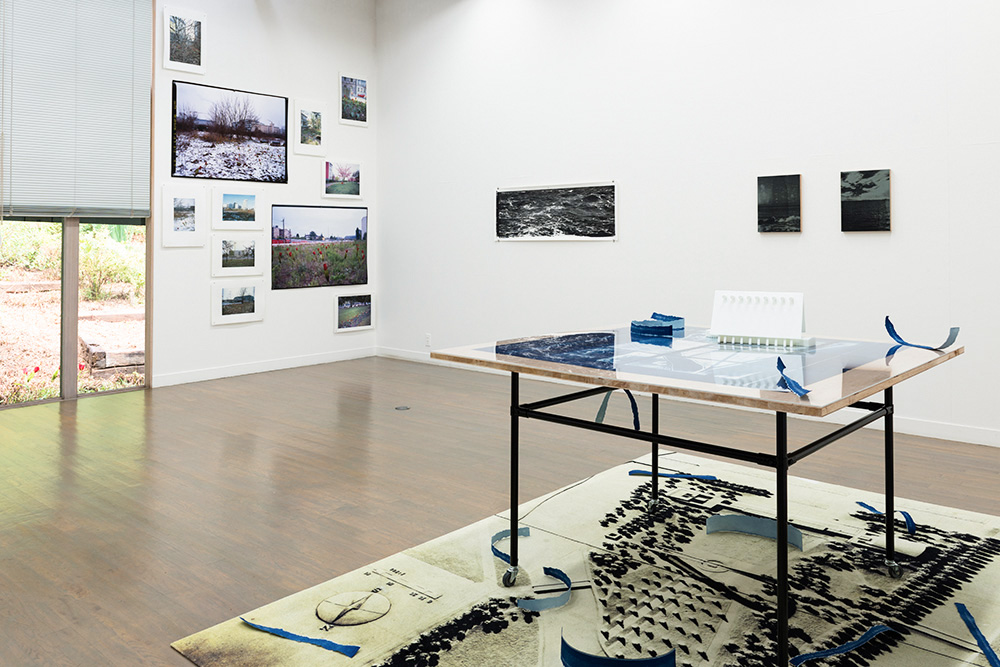
流転のなりゆき
武田竜真 福田 惠 古堅太郎
2023年9月2日[土]- 11月19日[日]
10:00-17:30(入館は17:00まで)
毎週:月・火・水曜休館
入館料:一般800円、学生600円(小学生400円)
※ 11月20日[月]- 12月6日[水]は、展示替え期間のため休館となります。
■ 出品作家、3名による自作解説をYouTubeにて公開いたしました。(撮影日:2023年9月1日)
■ 9月2日[土]14:00より オープニング・パーティーを行います。
今から170年前、横須賀市の浦賀港に来航した黒船は、寄港した先々で日本の植物を採取し、アメリカに持ち帰っていました。その植物標本は、太平洋に隔てられた日本とアメリカ東北部の植物がよく似ている事実を証明し、約1万1000年前まで、シベリア東端とアラスカ西部が地続きで、しかも温暖な気候であったこと、さらに、そこに生えていた植物が、気候変動や大陸の移動により、両大陸に分布したことを示唆しました。
捕鯨の漁場や補給地としての価値が黒船を引き寄せ、植民地主義的な調査として採取された植物が、種の分布と変化、何万年もの大陸の移動と気候変動を証明したように、ものは移動し、流転することで自らの価値を変化させ、場所の記憶と想起に深く関わっていきます。
武田竜真、福田惠、古堅太郎は、それぞれ文化を継ぐ漆と土地を隔てる海、枯れない造花と消えてしまった空き地、平和記念公園とプロパガンダ建築のように、相反するものが流転し、その意味を変え、場所の記憶と想起に影響を与えていく様を物語ります。
漆の特性と歴史に着目する武田竜真は、大航海時代に多くの漆製品が日本からヨーロッパ諸国に輸出されたことから、国間を文化的に「継ぐ」存在として漆を作品に使用しています。また、船によって運ばれたことから、海が土地を隔てる壁でもあるが、遠い異国と繋がる道でもあると考えます。この数百年にわたり日本と多くの国々を文化的に繋げていた「漆」という素材を用いて、海が切り開いた近・現代社会 の根幹とも言える「モビリティ(移動性、流動性)」を、波が見せる一瞬の表情を切り取ることで提示します。
福田惠は、2004年にドイツの首都、ベルリンに移住し、急激な都市開発で消えていく空き地に造花を植え「永遠の庭(よそ者として、ベルリン)」を制作しました。東西ドイツ統合の齟齬と希望を同時に孕む2000年代のベルリンを背景に、大量の造花と共に、めまぐるしく変容する都市に介入する行為は、身体を通じて、塗り替えられていく記憶や歴史に向き合った記録でもあります。現在は失われてしまった風景としての「永遠の庭」は、枯れない造花と共に17年前の都市の記憶を鮮やかに想起させます。
古堅太郎は、広島の平和記念公園をデザインした建築家の丹下健三が、終戦の3年前に「大東亜建設記念営造計画」を課題とした競技設計で一等を獲得していたことに注目しました。実現されることのなかったこの競技案と平和記念公園のデザインの類似については多くの人が指摘していますが、特に興味深いのは、戦中のプロパガンダ建築と戦後の平和を象徴する建築が似ているという点です。「日本の帝国主義から入念に切り離された『平和』に戦中のプロガンダとの類似を見ることはできないだろうか?」と問う古堅は、上述した二作品のデザインに注目し、戦後の理想的な平和の中に持続される別の視点を探ろうと試みます。
CV 武田竜真・略歴 CV 福田恵・略歴 CV 古堅太郎・略歴
” In a Continuous State of Flux “
Tatsuma Takeda / Megumi Fukuda / Taro Furukata
September 2(Sat) – November 19 (Sun) 2023
10:00 – 17:30 (Last admission 17:00)
Closed on Mondays, Tuesdays and Wednesdays
Admission:
800 yen for adults
600 yen for students
400 yen for elementary school students
The Black Ships arrived 170 years ago at Uraga Harbor, Yokosuka, in search for a whaling base and a supply site. They collected Japanese native plants at each port of call and brought them back to the United States. These plant specimens proved that Japan and the Northeast of the United States, which are separated by the Pacific Ocean, were very similar in vegetation, and suggested that until about 11,000 years ago, the easternmost part of Siberia and the westernmost part of Alaska had been continuous and had a warm climate, and furthermore the plants that grew there had been distributed to both continents due to the climate change and continental drift.
Just as the plants collected by the Black Ships in the context of colonialist research demonstrated species distribution, species change, and in turn the continental drift and climate change over tens of thousands of years, things move and change their own value in flux, and get deeply involved in the memory and reminiscence of a place.
Tatsuma Takeda, Megumi Fukuda, and Taro Furukata describe the way opposing concepts flow, change their meaning, and affect the memory and reminiscence of a place, by means of lacquer as a carrier of tradition and the ocean dividing the land, immortal artificial flowers and lost vacant lot, and the Peace Memorial Park and propaganda architecture, respectively.
Tatsuma Takeda, focusing on the characteristics and history of lacquer, uses lacquer in his works as a cultural bond between countries, inspired from the fact that many lacquer products were exported from Japan to European countries during the Age of Discovery. Since they were transported by ship, he also considers the ocean a barrier separating lands but also a road connecting distant countries. Using lacquer, which has culturally connected Japan to numerous countries over several hundred years, the artist presents mobility as the basis of modern and present-day society developed by the sea, through capturing expressions of fleeting waves.
In 2004, Megumi Fukuda moved to Berlin, where she created “eternal garden Berlin, as a stranger” by planting artificial flowers in vacant lots being lost due to galloping urban development. Against the backdrop of Berlin of the 2000s, a place of hope and inconsistency of the integration of East and West Germany, this work intervening in the rapidly transforming city with an enormous number of artificial flowers was also a record of the artist’s bodily confrontation with memory and history being rewritten. The “eternal garden” as a lost landscape vividly evokes the memory of the city of 17 years ago, with the artificial flowers that never wither.
Taro Furukata paid attention to the fact that architect Kenzo Tange, who designed the Peace Memorial Park in Hiroshima, had won the first prize in a design competition for a project “The Greater East Asia Co-Prosperity Sphere Memorial Hall” three years prior to the end of the war. Although many have pointed out similarities between this competition submission and the Peace Memorial Park, the resemblance between the pro-war propaganda architecture and the symbol of peace after the war is particularly noteworthy. In search for different perspectives in the ideal of postwar peace, the artist looks for similarities with the wartime propaganda in the “peace” carefully distanced from Imperial Japan.